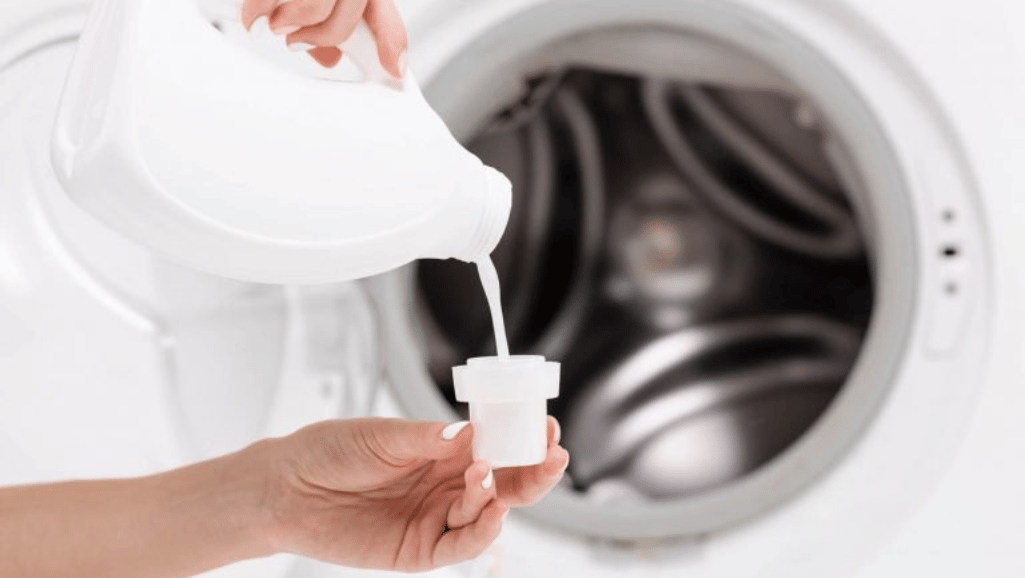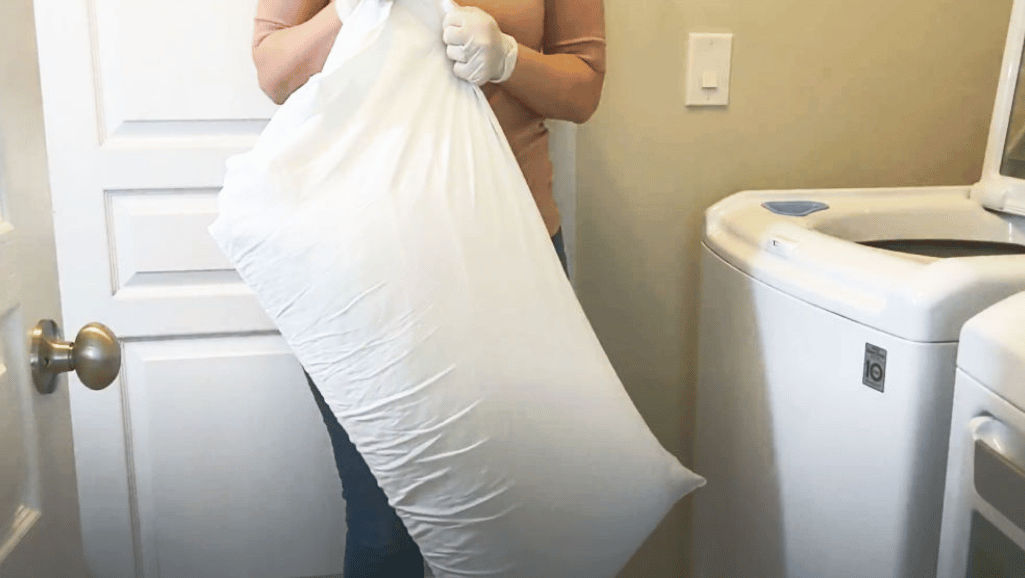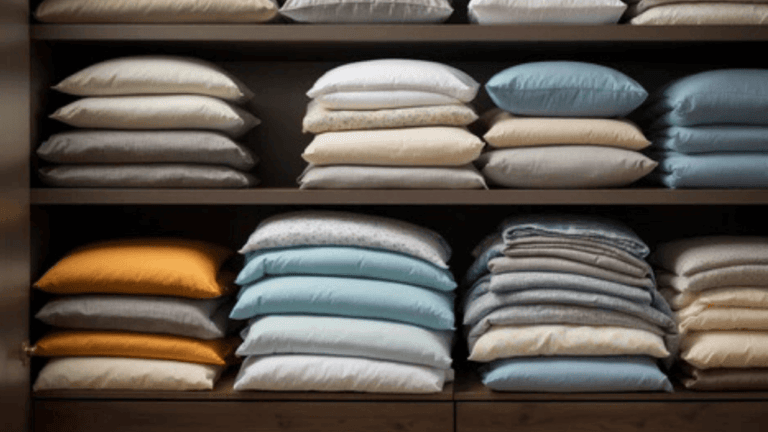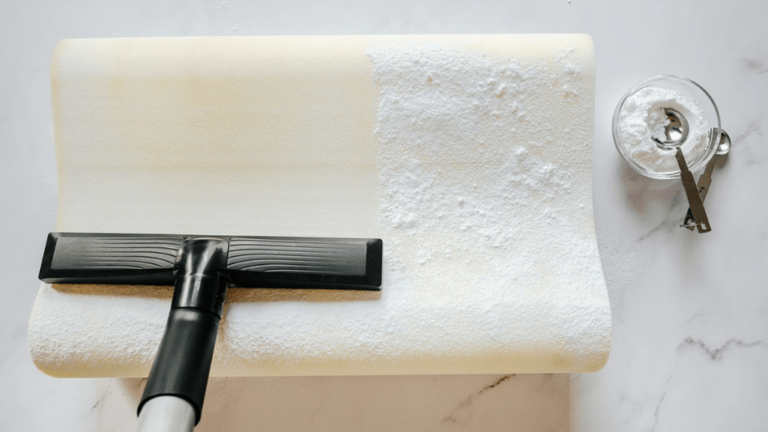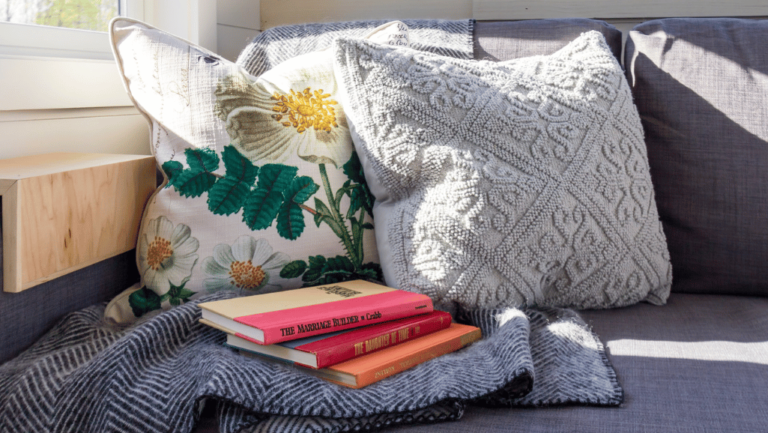Maintaining your pillows well is key for hygiene and their life span. Dust, skin cells, and oils can lead to allergies and impact your sleep. It’s important to use the right washing techniques to keep your pillows soft and supportive. This guide will show you how to machine wash your pillows the right way. It’s perfect for those who are too busy for hand washing or going to a professional cleaner.
With machine washable pillows, you can spend less time on cleaning and more time enjoying a restful sleep, free of allergens. In this detailed guide, you’ll learn all the pillow cleaning tips to maintain your pillows well. We’ll cover the essential steps and share tips on washing bed pillows in a machine. This ensures your sleep area is both clean and comfortable.
Key Takeaways
- Machine washing pillows can help remove dust, skin cells, and oils.
- Proper maintenance extends the life and quality of your pillows.
- Effective pillow cleaning can lead to better sleep.
- It’s important to use the right washing methods for different types of pillows.
- This guide is for people with busy lives, offering practical advice on washing.
Why It’s Important to Machine Wash Your Pillows Regularly
Washing your pillows often doesn’t only keep them looking good. It also helps keep you healthy. Your pillows can gather a mix of things like dust mites, sweat, and drool. Cleaning them right removes these and stops you from getting sick. In 2018, a study found that machine washing is the top way to clean pillows well.
Most pillow types can go in the washer. Use warm water and a gentle cycle. But, pillows filled with latex or memory foam need a different approach. They can’t go in the machine but can stay clean with spot cleaning.
In 2021, a study discovered some pillows fight off dirt and dust mites better. Pillows with latex foam, memory foam, hypoallergenic materials, and gel stay cleaner. Goose down pillows have fewer mites than wool ones.
Washing your pillows every three to six months makes them last longer. Synthetic pillows tend to gather more dust. So, they need washing more often. Quality pillows, like latex or memory foam, can go 3 to 4 years before you should replace them. But synthetic ones might need changing every 6 months to 2 years.
Always wash two pillows together to keep your machine balanced and safe. Change your pillows every 1.5 to 2 years. This keeps them comfy and clean.
Also, airing your pillows monthly helps them stay fresh. For total bed cleanliness, wash sheets, pillowcases, and duvet covers every 1 to 2 weeks. Do comforters once a year, and spot clean as needed.
Finally, using protectors for pillows and mattresses is a great idea. It stops dust and mites from gathering. This makes your sleeping space much cleaner and healthier.
Pre-Wash Preparation for Machine Washable Pillows
Before washing throw pillows, make sure to prep them well. This step helps you follow the pillow care instructions properly. This way, your pillows stay clean without any damage.
Check the Care Label
Start by looking at the care label. These labels give you special instructions for your pillows. Following these instructions avoids any harm to your pillows.
Remove Pillow Covers
Don’t forget to take off the pillow covers. They need to be washed differently than the pillows. Cleaning throw pillows without covers makes sure they get fully clean.
Spot Clean Stains
Also, treat any stains you see before washing. Addressing stains early makes the whole cleaning process more effective. Use a soft detergent and a gentle touch to clean the stains.
By doing these steps before machine washing, you keep your pillows looking good for a long time.
How to Machine Wash Pillows: Step-by-Step
Knowing the best way to wash pillows in a machine is key to take care of them. You need to think about the machine’s settings, the type of detergent, and how to balance the load. This guide will make it easy for you to keep your pillows clean.
Select the Right Machine Settings
First, pick a gentle cycle and warm water when washing pillows in a machine. This choice helps clean them without harm. Choosing the right options also keeps pillows soft, whether they’re stuffed with cotton, feathers, down, or fiberfill.
Choose the Proper Detergent
Go for a mild, low-sudsing detergent when you wash pillows in a machine. Tough detergents can damage the pillow’s materials. Plus, low-sudsing ones wash out fully, so there’s no residue left. This can prevent any discomfort or allergic reactions.
Balancing the Load
Washing two pillows together helps keep your washing machine in balance. This stops the machine from shaking too much, which could harm it and the pillows. An even load ensures they get cleaned well and that your machine lasts longer.
Tips for Washing Different Types of Pillows
Caring for various pillows makes them last longer and stay clean. Each type needs a special way to wash it. We’ll show you how to wash feather pillows, memory foam pillows, and polyester pillows.
Feather and Down Pillows
When cleaning feather and down pillows, always choose a gentle cycle. Use warm water with a bit of mild detergent. For best results, wash two pillows together. But make sure your washing machine doesn’t get lopsided.
After washing, thoroughly rinse to get rid of all detergent. Drying right is key. Set your dryer to low heat. Toss in a few clean tennis balls to fluff them up.
Memory Foam Pillows
Memory foam pillows need special care. Don’t put them in a washing machine. To clean them, just spot clean with mild detergent and a damp cloth. Don’t use too much water.
Let the foam pillow air dry completely. This helps avoid mold.
Polyester and Fiberfill Pillows
Polyester pillows are durable and can handle more washes. Again, use a gentle cycle with warm water and mild detergent. Washing two pillows together is good. It keeps the washing machine balanced.
Dry these pillows on a low setting. Toss in a few tennis balls. This tricks helps them keep their shape and fluff.
Best Practices for Washing Bed Pillows
Maintaining clean bed pillows is vital. It keeps them fresh and supports their long life. Using the right tips in your cleaning routine keeps pillows soft and fights allergens and bacteria.
Use Mild Detergent
It’s best to wash pillows with mild detergent. This keeps the fabric strong and the pillow supportive for longer. Use gentle liquid detergents without harsh fragrances when cleaning your pillows.
Avoid Fabric Softeners
Skip fabric softeners when washing your pillows. They might make the pillows seem fluffier, but they can do more harm than good. Fabric softeners can reduce the pillow’s freshness and trap allergens.
By following these tips, you make sure your pillows last longer and stay comfy. They also make your sleep zone cleaner and healthier. Good maintenance supports not just comfort, but also the durability of your pillows.
How Often Should You Wash Your Pillows?
Having a cleaning schedule for pillows is key for clean sleep. The American Cleaning Institute says clean them every three to six months. This stops allergens and bacteria from building up. It keeps your bed fresh and healthy.
Experts have different tips depending on how you use your pillows. Leslie Reichert says clean them every three months. Vera Peterson from Molly Maid suggests twice a year, or every quarter if you use them a lot.
How much you use your pillows and your habits matter too. If pets stay on your bed, you sweat a lot at night, or eat in bed, clean them every three months.
| Expert | Recommended Cleaning Frequency |
|---|---|
| American Cleaning Institute | Every 3-6 months |
| Leslie Reichert | Every 3 months |
| Vera Peterson | Twice a year or quarterly |
Remember, regular cleaning is great, but sometimes you should get new pillows. Change them every year and a half to two years. This way, you won’t sleep with old, bacteria-filled pillows. Keeping a steady cleaning schedule for pillows and changing them when needed makes a big difference in how well you sleep.
Drying Pillows After Machine Washing
Drying pillows the right way is key. It keeps them in good shape and stops mold or bad smells.
Using a Dryer
For synthetic pillows, low-heat is best. For feather or down, use the air setting to keep feathers safe. Toss in some tennis balls to fluff your pillows and stop them from clumping.
Air Drying Method
Memory foam and latex pillows are too fragile for the dryer. Let them air-dry in a breezy spot. space them out well for better drying. You can use this method for other pillow types too, if you are in no hurry and want to avoid using chemicals.
Fluffing and Reshaping
After drying, make sure to fluff your pillows by hand. This boosts their softness and shape. Doing this often keeps your pillows comfy and smooth for a better sleep.
Pillow Care Instructions for Longevity
To keep your pillows in top shape, follow some simple rules. Things like fluffing them, using protectors, and storing them right are important. They help your pillows stay comfy for a long time.
Regular Fluffing
Fluff up your pillows often to keep them plump and comfy. This spreads the filling out evenly, stopping lumps and dips. Doing this every day makes a big difference in keeping your pillows nice.
Using Pillow Protectors
Pillow protectors stop dust, mites, and spills from ruining your pillows. Pick ones that let your pillows breathe, to avoid extra moisture. They’re an easy way to make your pillows last longer and stay clean.
Storing Pillows Properly
Storing your pillows right is a must for keeping them fresh. Keep them in a cool, dry spot out of the sun. Don’t stack heavy stuff on them to prevent them from getting flat.
These storage tips keep your pillows feeling great for a long time.
Common Mistakes to Avoid When Washing Pillows
Washing pillows keeps them clean and makes them last longer. Yet, many make mistakes that hurt their pillows. Follow these key machine wash pillow tips to wash without trouble:
1. Overloading the Washing Machine: Don’t put too many pillows in at once. Washing just two ensures each gets clean properly. This also lowers the risk of machine damage.
2. Using Excessive Detergent: Too much detergent is a big no. It’s hard to wash it all out, and the leftover can harm your pillows. Always use just enough detergent to get the job done.
3. Washing Incorrect Pillow Types: Some pillows can’t handle the washing machine. Take memory foam, for example, which needs gentle hand washing. Always wash each pillow type the right way to keep them in good shape.
4. Neglecting Proper Drying: Drying matters just as much as washing. Avoid mold by air drying or using low heat in the dryer. To keep pillows fluffy, throw in a few tennis balls. Make sure there’s good airflow during air drying to prevent moisture from staying inside.
5. Ignoring Care Labels: Every pillow has specific care instructions. Not following them can ruin your pillows. Always check the care label before starting, it gives the best machine wash pillow tips.
6. Incorrect Stain Removal: Treating stains before washing is a smart move. A mix of vinegar, dishwasher soap, baking soda, and laundry detergent works well on tough stains. It stops stains from setting during washing.
Remember these machine wash pillow tips to keep your pillows fresh and clean. They’ll also stay in good condition for longer.
Conclusion
Keeping your pillows clean is key for a healthy and comfy sleep spot. This article guides you on how to keep your pillows fresh. You’ll learn smart ways to clean different kinds of pillows. Plus, how to wash and dry them right.
Pillows made from polyester, feathers, or down need special care. Knowing how to clean them properly keeps them like new. When washing, choose the right machine settings and detergent. Make sure your machine isn’t too full.
For foam or latex pillows, avoid the washing machine. It’s better to hand-wash or do a light spot-clean. The way you dry your pillows matters a lot. Use tennis balls for feather pillows to keep them fluffy. And, let foam pillows air dry to keep their shape.
Did you know the Better Sleep Council recommends washing pillowcases weekly? And that the pillows underneath should get a good clean every few months? Following this advice helps you sleep better and keep your pillows longer. With these tips, you’re all set to care for your pillows well.


